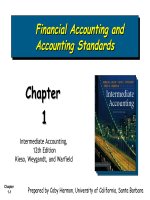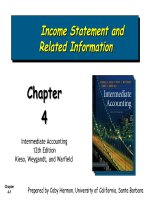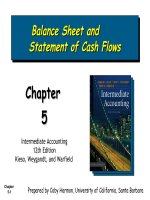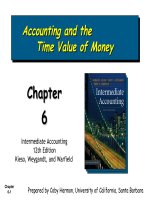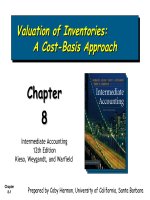Intermediate accounting 12th edition kieso warfield chapter 21
Bạn đang xem bản rút gọn của tài liệu. Xem và tải ngay bản đầy đủ của tài liệu tại đây (390.5 KB, 53 trang )
Accounting
Accounting for
for Leases
Leases
Chapter
21
Intermediate Accounting
12th Edition
Kieso, Weygandt, and Warfield
Chapter
21-1
Prepared by Coby Harmon, University of California, Santa Barbara
Learning
Learning Objectives
Objectives
1.
Explain the nature, economic substance, and advantages of lease
transactions.
2.
Describe the accounting criteria and procedures for capitalizing
leases by the lessee.
3.
Contrast the operating and capitalization methods of recording
leases.
4.
Identify the classifications of leases for the lessor.
5.
Describe the lessor’s accounting for direct-financing leases.
6.
Identify special features of lease arrangements that cause
unique accounting problems.
7.
Describe the effect of residual values, guaranteed and
unguaranteed, on lease accounting.
8.
Describe the lessor’s accounting for sales-type leases.
9.
List the disclosure requirements for leases.
Chapter
21-2
Accounting
Accounting for
for Leases
Leases
Leasing
Environment
Who are
players?
Advantages of
leasing
Conceptual
nature of a lease
Accounting
Lessee
Capitalization
criteria
Accounting
differences
Capital lease
method
Operating
method
Comparison
by
Accounting
Lessor
by
Economics of
leasing
Classification
Direct-financing
method
Operating
method
Special
Accounting
Problems
Residual values
Sales-type
leases
Bargain
purchase option
Initial direct costs
Current versus
noncurrent
Disclosure
Unsolved
problems
Chapter
21-3
The
The Leasing
Leasing Environment
Environment
A lease is a contractual agreement between a lessor
and a lessee, that gives the lessee the right to use
specific property, owned by the lessor, for a
specified period of time.
Largest group of leased equipment involves:
Information technology,
Transportation (trucks, aircraft, rail),
Construction and
Agriculture.
Chapter
21-4
LO 1 Explain the nature, economic substance,
and advantages of lease transactions.
The
The Leasing
Leasing Environment
Environment
Who Are the Players?
Three general categories:
Banks.
Captive leasing companies.
Independents.
Chapter
21-5
LO 1 Explain the nature, economic substance,
and advantages of lease transactions.
The
The Leasing
Leasing Environment
Environment
Advantages of Leasing
1.
100% Financing at Fixed Rates.
2. Protection Against Obsolescence.
3. Flexibility.
4. Less Costly Financing.
5. Tax Advantages.
6. Off-Balance-Sheet Financing.
Chapter
21-6
LO 1 Explain the nature, economic substance,
and advantages of lease transactions.
The
The Leasing
Leasing Environment
Environment
Conceptual Nature of a Lease
Capitalize a lease that transfers substantially all
of the benefits and risks of property ownership,
provided the lease is noncancelable.
Leases that do not transfer substantially all the
benefits and risks of ownership are operating
leases.
Chapter
21-7
LO 1 Explain the nature, economic substance,
and advantages of lease transactions.
The
The Leasing
Leasing Environment
Environment
The issue of how to report leases is the case of substance versus
form. Although technically legal title may not pass, the benefits
from the use of the property do.
Operating Lease
Journal Entry:
Rent expense
Cash
xxx
xxx
Capital Lease
Journal Entry:
Leased equipment
Lease obligation
xxx
xxx
A lease that transfers substantially all of the benefits and risks of
property ownership should be capitalized (only noncancellable leases
may be capitalized).
Statement of Financial Accounting Standard No. 13,
for Leases,” 1980
Chapter
21-8
“Accounting
LO 1 Explain the nature, economic substance,
and advantages of lease transactions.
Accounting
Accounting by
by the
the Lessee
Lessee
If the lessee capitalizes a lease, the lessee records
an asset and a liability generally equal to the present
value of the rental payments.
Records depreciation on the leased asset.
Treats the lease payments as consisting of
interest and principal.
Chapter
21-9
LO 2 Describe the accounting criteria and procedures
for capitalizing leases by the lessee.
Accounting
Accounting by
by the
the Lessee
Lessee
To record a lease as a capital lease, the lease must
be noncancelable.
One or more of four criteria must be met:
1. Transfers ownership to the lessee.
2. Contains a bargain purchase option.
3. Lease term is equal to or greater than 75 percent of
the estimated economic life of the leased property.
4. The present value of the minimum lease payments
(excluding executory costs) equals or exceeds 90
percent of the fair value of the leased property.
Chapter
21-10
LO 2 Describe the accounting criteria and procedures
for capitalizing leases by the lessee.
Accounting
Accounting by
by the
the Lessee
Lessee
Leases that DO NOT
meet any of the four
criteria are accounted for
as Operating Leases.
Lease Agreement
No
No
No
Transfer
of
Ownership
Bargain
Purchase
Lease Term
>= 75%
PV of
Payments
>= 90%
Yes
Yes
Yes
Yes
Capital Lease
Chapter
21-11
No
O
p
e
r
a
t
i
n
g
L
e
a
s
e
LO 2 Describe the accounting criteria and procedures
for capitalizing leases by the lessee.
Accounting
Accounting by
by the
the Lessee
Lessee
Recovery of Investment Test (90% Test)
Discount Rate
Lessee computes the present value of the
minimum lease payments using its incremental
borrowing rate, with one exception.
If the lessee knows the implicit interest
rate computed by the lessor and it is less
than the lessee’s incremental borrowing rate,
then lessee must use the lessor’s rate.
Chapter
21-12
LO 2 Describe the accounting criteria and procedures
for capitalizing leases by the lessee.
Accounting
Accounting by
by the
the Lessee
Lessee
Recovery of Investment Test (90% Test)
Minimum lease payments:
Minimum rental payment
Guaranteed residual value
Penalty for failure to renew
Bargain purchase option
Executory Costs:
Chapter
21-13
Insurance
Maintenance
Taxes
Exclude from PV of
Minimum Lease
Payment calculation
LO 2 Describe the accounting criteria and procedures
for capitalizing leases by the lessee.
Accounting
Accounting by
by the
the Lessee
Lessee
Asset and Liability Accounted for Differently
Asset and Liability Recorded at the lower of:
1. the present value of the minimum lease
payments (excluding executory costs) or
2. the fair-market value of the leased asset.
Chapter
21-14
LO 2 Describe the accounting criteria and procedures
for capitalizing leases by the lessee.
Accounting
Accounting by
by the
the Lessee
Lessee
Asset and Liability Accounted for Differently
Depreciation Period
If lease transfers ownership, depreciate asset
over the economic life of the asset.
If lease does not transfer ownership,
depreciate over the term of the lease.
Chapter
21-15
LO 2 Describe the accounting criteria and procedures
for capitalizing leases by the lessee.
Accounting
Accounting by
by the
the Lessee
Lessee
E21-1 (Capital Lease with Unguaranteed Residual Value) On
January 1, 2007, Burke Corporation signed a 5-year noncancelable
lease for a machine. The terms of the lease called for Burke to
make annual payments of $8,668 at the beginning of each year,
starting January 1, 2007. The machine has an estimated useful life
of 6 years and a $5,000 unguaranteed residual value. Burke uses
the straight-line method of depreciation for all of its plant assets.
Burke’s incremental borrowing rate is 10%, and the Lessor’s
implicit rate is unknown.
Instructions
(a) What type of lease is this? Explain.
(b) Compute the present value of the minimum lease payments.
(c) Prepare all journal entries for Burke through Jan. 1, 2008.
Chapter
21-16
LO 2 Describe the accounting criteria and procedures
for capitalizing leases by the lessee.
Accounting
Accounting by
by the
the Lessee
Lessee
E21-1 What type of lease is this? Explain.
Capitalization Criteria:
Capital Lease, #3
NO
NO
1. Transfer of ownership
2. Bargain purchase option
3. Lease term => 75% of
economic life of leased
property
4. Present value of minimum
lease payments => 90% of
FMV of property
Chapter
21-17
Lease term
5 yrs.
Economic life
FMV of leased
6 yrs.
property is unknown.
YES
LO 2 Describe the accounting
83.3%criteria and procedures
for capitalizing leases by the lessee.
Accounting
Accounting by
by the
the Lessee
Lessee
E21-1 Compute present value of the minimum lease payments.
Payment
8,668
$
Present value factor (i=10%,n=5)
4.16986
Journal
entry
PV of
minimum lease payments
Leased Machine Under Capital Lease
1/1/07
$36,144
Leases liability
Leases liability
Cash
Chapter
21-18
36,144
8,668
36,144
8,668
LO 2 Describe the accounting criteria and procedures
for capitalizing leases by the lessee.
Accounting
Accounting by
by the
the Lessee
Lessee
E21-1 Lease Amortization Schedule
Date
Lease
Payment
10%
Interest Reduction
Expense in Liability
1/1/07
1/1/07
Chapter
21-19
Lease
Liability
$ 36,144
$ 8,668
$ 8,668
27,476
12/31/07
8,668
2,748
5,920
21,556
12/31/08
8,668
2,156
6,512
15,044
12/31/09
8,668
1,504
7,164
7,880
12/31/10
8,668
788
7,880
0
LO 2 Describe the accounting criteria and procedures
for capitalizing leases by the lessee.
Accounting
Accounting by
by the
the Lessee
Lessee
E21-1 Journal entries for Burke through Jan. 1, 2008.
Journal entry
12/31/07
Depreciation expense
Accumulated depreciation
7,229
7,229
($36,144 ÷ 5 = $7,229)
Interest expense
Interest payable
2,748
2,748
[($36,144 – $8,668) X .10]
Chapter
21-20
LO 2 Describe the accounting criteria and procedures
for capitalizing leases by the lessee.
Accounting
Accounting by
by the
the Lessee
Lessee
E21-1 Journal entries for Burke through Jan. 1, 2008.
Journal entry
1/1/08
Chapter
21-21
Lease liability
Interest payable
Cash
5,920
2,748
8,668
LO 2 Describe the accounting criteria and procedures
for capitalizing leases by the lessee.
Accounting
Accounting by
by the
the Lessee
Lessee
E21-1 Comparison of Capital Lease with Operating Lease
Date
E21-1 Capital Lease
Depreciation Interest
Expense
Expense
Total
Operating
Lease
Expense
2007
$
$
7,229
$ 2,748
2008
7,229
2,156
2009
7,229
2009
7,229
2010
7,228 *
$
36,144
8,668
$ 1,309
9,385
8,668
717
1,504
8,733
8,668
65
788
8,017
8,668
(651)
7,228
8,668
(1,440)
43,340
$ 43,340
0
$ 7,196
$
$
9,977
Diff.
* rounding
Chapter
21-22
LO 3 Contrast the operating and capitalization methods of recording leases.
Accounting
Accounting by
by the
the Lessor
Lessor
Benefits to the Lessor
1.
Interest Revenue.
2. Tax Incentives.
3. High Residual Value.
Chapter
21-23
LO 4 Identify the classifications of leases for the lessor.
Accounting
Accounting by
by the
the Lessor
Lessor
Economics of Leasing
A lessor determines the amount of the rental, based
on the rate of return needed to justify leasing the
asset.
If a residual value is involved (whether guaranteed or
not), the company would not have to recover as much
from the lease payments
Chapter
21-24
LO 4 Identify the classifications of leases for the lessor.
Accounting
Accounting by
by the
the Lessor
Lessor
E21-10 (Computation of Rental) Morgan Leasing Company signs
an agreement on January 1, 2007, to lease equipment to Cole
Company. The following information relates to this agreement.
1.
The term of the noncancelable lease is 6 years with no renewal option.
The equipment has an estimated economic life of 6 years.
2.
The cost of the asset to the lessor is $245,000. The fair value of the
asset at January 1, 2007, is $245,000.
3.
The asset will revert to the lessor at the end of the lease term at
which time the asset is expected to have a residual value of $43,622,
none of which is guaranteed.
4.
The agreement requires annual rental payments, beg. Jan. 1, 2007.
5.
Collectibility of the lease payments is reasonably predictable. There
are no important uncertainties surrounding the amount of costs yet to
be incurred by the lessor.
Chapter
21-25
LO 4 Identify the classifications of leases for the lessor.


